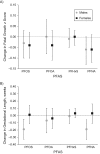Early-Pregnancy Plasma Concentrations of Perfluoroalkyl Substances and Birth Outcomes in Project Viva: Confounded by Pregnancy Hemodynamics?
- PMID: 29155920
- PMCID: PMC5884712
- DOI: 10.1093/aje/kwx332
Early-Pregnancy Plasma Concentrations of Perfluoroalkyl Substances and Birth Outcomes in Project Viva: Confounded by Pregnancy Hemodynamics?
Abstract
Associations of prenatal exposure to perfluoroalkyl substances (PFAS), ubiquitous chemicals used in stain- and water-resistant products, with adverse birth outcomes may be confounded by pregnancy hemodynamics. We measured plasma concentrations of 4 PFAS in early pregnancy (median length of gestation, 9 weeks) among 1,645 women in Project Viva, a study of a birth cohort recruited during 1999-2002 in eastern Massachusetts. We fitted multivariable models to estimate associations of PFAS with birth weight-for-gestational age z score and length of gestation, adjusting for sociodemographic confounders and 2 hemodynamic markers: 1) plasma albumin concentration, a measure of plasma volume expansion, and 2) plasma creatinine concentration, used to estimate glomerular filtration rate. Perfluorooctane sulfonate (PFOS) and perfluorononanoate (PFNA) were weakly inversely associated with birth weight-for-gestational age z scores (adjusted β = -0.04 (95% confidence interval (CI): -0.08, 0.01) and adjusted β = -0.06 (95% CI: -0.11, -0.01) per interquartile-range increase, respectively). PFOS and PFNA were also associated with higher odds of preterm birth (e.g., for highest PFOS quartile vs. lowest, adjusted odds ratio = 2.4, 95% CI: 1.3, 4.4). Adjusting for markers of pregnancy hemodynamics (glomerular filtration rate and plasma albumin), to the extent that they accurately reflect underlying pregnancy physiology, did not materially affect associations. These results suggest that pregnancy hemodynamics may not confound associations with birth outcomes when PFAS are measured early in pregnancy.
Figures

Comment in
-
Invited Commentary: Exposure Biomarkers Indicate More Than Just Exposure.Am J Epidemiol. 2018 Apr 1;187(4):803-805. doi: 10.1093/aje/kwx333. Am J Epidemiol. 2018. PMID: 29155925
-
THE AUTHORS REPLY.Am J Epidemiol. 2018 Apr 1;187(4):896. doi: 10.1093/aje/kwy010. Am J Epidemiol. 2018. PMID: 29351611 No abstract available.
-
RE: "INVITED COMMENTARY: EXPOSURE BIOMARKERS INDICATE MORE THAN JUST EXPOSURE".Am J Epidemiol. 2018 Apr 1;187(4):894-895. doi: 10.1093/aje/kwy009. Am J Epidemiol. 2018. PMID: 29351641 Free PMC article. No abstract available.
References
-
- Calafat AM, Kuklenyik Z, Reidy JA, et al. . Serum concentrations of 11 polyfluoroalkyl compounds in the US population: data from the National Health and Nutrition Examination Survey (NHANES). Environ Sci Technol 2007;41(7):2237–2242. - PubMed
-
- Lau C, Butenhoff JL, Rogers JM. The developmental toxicity of perfluoroalkyl acids and their derivatives. Toxicol Appl Pharmacol 2004;198(2):231–241. - PubMed
-
- Olsen GW, Butenhoff JL, Zobel LR. Perfluoroalkyl chemicals and human fetal development: an epidemiologic review with clinical and toxicological perspectives. Reprod Toxicol 2009;27(3–4):212–230. - PubMed
Publication types
MeSH terms
Substances
Grants and funding
LinkOut - more resources
Full Text Sources
Other Literature Sources
Medical

